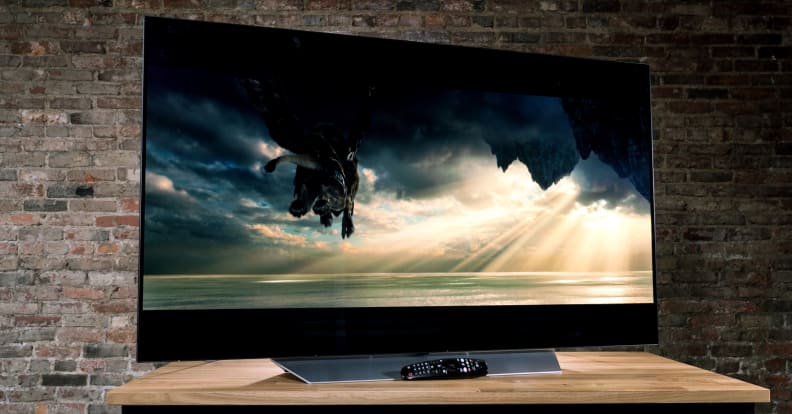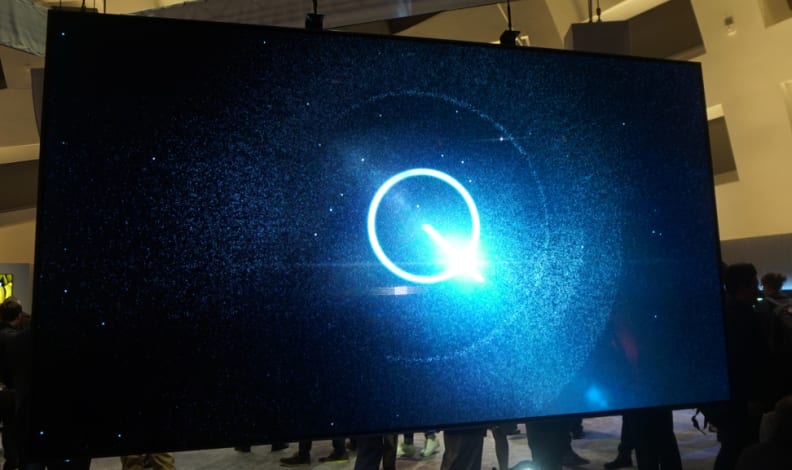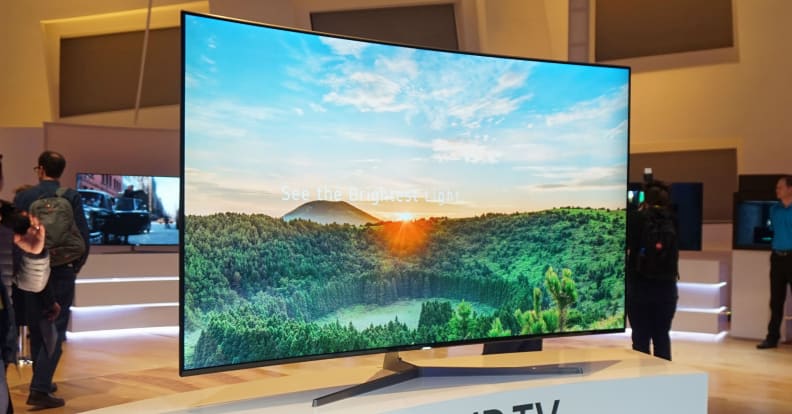Can Samsung's gorgeous new QLED TVs take back the living room?
A nugget of truth in the alphabet soup
Products are chosen independently by our editors. Purchases made through our links may earn us a commission.
For the last few years, OLED TVs—all manufactured by Samsung's chief rival, LG—have topped our charts and earned our awards for their incredible picture quality. But that doesn't mean the classic LED/LCD TV is done yet; they still dominate sales, and they're better suited to bright rooms.
And in fact, Samsung has been working to produce LEDs that are viable OLED competitors for the last couple of years. You may have seen the company's breathtaking commercials for their new "QLED" TVs. And it certainly sounds a lot like "OLED," doesn't it?
It could be argued that the QLED branding is purposefully muddying the waters for buyers who have vaguely heard that OLED is great. In fact, it's almost blatant: the "Q" looks enough like an "O" that Samsung may be gunning for respect-by-association. But behind the marketing BS, these are actually some beautifully engineered TVs.
OLED vs. QLED

{{ amazon name="LG Electronics OLED55B6P Flat 55-Inch 4K Ultra HD Smart OLED TV (2016 Model)", asin="B01CDF9S1G", align="right" }}
The first thing confused consumers need to understand is that "QLED" is not a new type of technology—at least, not really. Samsung's QLED TVs are, most simply defined, LED TVs with quantum dot enhancements. This is different from OLED TVs, which are "emissive" displays that do not use backlights. The primary difference is that OLEDs do not have backlights, while QLED TVs do.
The biggest perceptible difference comes down to brightness:
• OLED TVs turn each pixel on or off individually. This means when they produce black, shadowy content, it is truly black.
• QLED (LED) TVs get much, much brighter than current OLED TVs. The brightest OLED this year hits around 700 nits. Samsung claims its QLED TVs can hit between 1,500 and 2,000 nits. Based on the performance of last year's "SUHD" models (which were also LED TVs using quantum dots), we very much expect to see brightness well over 1,000 nits from Samsung's 2017 QLED lineup.
• Both TV types are very colorful. However, Samsung claims that they have worked with quantum dot developers to push QLED TV color to cover 100% of the DCI-P3 HDR color space. While OLED TVs are naturally very vivid in color, they haven't hit a full 100% coverage as of yet. However, it's so close you probably could never tell the difference. For reference, DCI P3 offers about a 25% increase in color saturation over the previous standard, Rec. 709.

Samsung's 2017 QLED models promise an almost blinding level of brightness and color.
Therefore, the biggest operational difference between QLED and OLED comes about during playback of HDR (High Dynamic Range) content. While OLED's perfect blacks and emissive operation give them advantages in things like contrast and horizontal viewing angle, HDR content takes full advantage of the sheer overwhelming top-end brightness that QLED displays are capable of. OLED TVs always look incredible, but you have to see "over 1,000 nits" to really understand how futuristic and awesome it looks. This is QLED's biggest leg-up on OLED.
It really comes down to what kind of room you're watching in; in a brighter room, your eyes will likely not be able to appreciate the absolutely shadow/black tones that OLED is capable of. On the other hand, in a dimmer/dark home theater room, QLED TVs can be so bright that it's almost uncomfortable to watch, in my experience.
Pricing & Availability
As you might expect, both the 2017 OLEDs and 2017 QLEDs are very expensive where the average buyer is concerned. Let's compare the series and prices (rounded for easier comparison):
Samsung Q9 Series (flagship)
• 65-inch (Samsung QN65Q9), $6,000 • 75-inch (Samsung QN75Q9), $10,000
LG W7 Series (flagship) (read our review)
• 65-inch (LG OLED65W7P), $8,000 • 77-inch (LG OLED77W7P), $20,000
LG G7 Series
• 65-inch (LG OLED65G7P), $7,000 • 77-inch (LG OLED77G7P), $17,000
Samsung Q8C Series (curved)
• 55-inch (Samsung QN55Q8C), $4,000 • 65-inch (Samsung QN65Q8C), $5,000 • 75-inch (Samsung QN75Q8C), price pending
Samsung Q7F Series
• 55-inch (Samsung QN55Q7F), $3,000 • 65-inch (Samsung QN65Q7F), $4,000 • 75-inch (Samsung QN75Q7F), $6,000
LG E7 Series
• 55-inch (LG OLED55E7P), $4,000 • 65-inch (LG OLED65E7P), $5,500
LG C7 Series (read our review)
• 55-inch (LG OLED55C7P), $3,500 • 65-inch (LG OLED65C7P), $5,000
Looking here, you can see that while no LG OLEDs or Samsung QLEDs are "affordable" by reasonable standards, there are comparable series in terms of price, depending on size. While both OLEDs and QLEDs are available the most popular 55- and 65-inch sizes, prices increase dramatically where the 70+ inch sizes are concerned, with the LED-based QLEDs offering much easier-to-stomach prices for 75-inch options than the jaw-dropping prices of the 77-inch OLEDs.
LG's OLED line also tends to improve in lockstep; the entry-level panels often perform exactly the same as the top-end ones, in our tests. For 2017, our tests already show that the $3,500 C7 series can match the $8,000 W7 flagship when it comes to picture quality. On the other hand, we aren't yet sure if the Samsung Q7F can hold a candle to the flagship Q9, as the quality can vary wildly from series-to-series with LED TVs.

So... what should I buy?
While it'd be easy to say that you should go with a QLED if your room is brighter, and an OLED if your room is darker, in truth it's not that simple. Most people will likely shoot for whatever is most affordable. And while we can more or less confirm that the cheapest OLEDs are nearly as good from a pure picture quality standpoint as the most expensive OLEDs, we can't yet confirm if the most affordable QLED TVs perform to the same standard as the flagship Q9.
This is because the main difference between the priciest OLED, the W7 Series, and one of the more affordable OLEDs, the C7, is almost entirely cosmetic. However, the difference between the QLED TVs is more striking.
However, this common assumption was disproved handily last year by two Samsung models: the KS9800 series and the KS8000 series, which have the similar differences in backlight structure as the Q9 and Q7F from this year, but were strikingly similar in their brightness range and color saturation. We therefore have high hopes for the 2017 QLED models, which should surpass last year's models on every front.
Fortunately, we have a Q7F model in house for testing right now. Check back soon for updates on how QLED stacks up.
